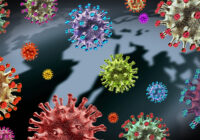You don’t have to be within an eyeshot of the great plains to know about the “culling” of the herd. Where I grew up, near a small farm in New England, we kids knew all about “culling.”
Across the road, on the far side of the cornfield, near the tree line, there would be a disturbance. Among the stubble of corn stalks, some mongrels would be scuffling in the snow, snarling on their haunches. Perhaps a half-frozen possum or maybe an old coon. We could see the snatches of fur. A large short-hair — a common name for a short-haired dog — was trying to carry it, dragging it with its mouth full, and with the others in the pack clenching to its dangling parts.
Too heavy, the short-hair dropped it and went after the nearest throat. The pack scavenged in his absence, snapping at the belly, tearing at it, hoping to trot off with a prize of the bowel. Open, torn, with noses and incisors inside the gut. Scattering before the short-hair’s vengeance and standing off from his low growls. Then dragging it again, lighter each time, and then back into the forest in a howl of dog’s breath and trampled snow.
Endless Culling
Predators have a nose for the weak, for the so-called “underlying conditions,” as epidemiologists call it today. No matter the predator — from fleas and mosquitoes to bacteria and the novel coronavirus. To the cheetah pulling down the antelope to the most savage predator of all, man, who in the 20th century alone “culled” out millions and millions of souls from those other humans inhabiting the earth in the countless wars.
And, tragically, that represents only the most visible “metric” of the culling of the species. It does not speak to that once-upon-a-time “Sweet Bird of Youth” who now sits sweating in a backroom of a motel-turned-old age facility. Just off the interstate, in the arms of the Haitian refugee who sticks her with more dope than the doc allows. Or the southland émigré who sits alone at dusk up on the fire escape overlooking the railway tracks of New York, New Haven and Hartford to bring in better those beloved Giants on his transistor. The last one “out” brings him inside, past his mattress to risk inching his way down the dark hall to move his bowels.
I left America to live and work for most of my adult life in so-called “countries under development” at humanitarian organizations. These were nations in Asia, Africa and the Middle East. I was well-fed as a child, well-educated as a teenager, well-cared for by a neurosurgeon when I was wounded in Vietnam and well-employed ever since.
Yet those millions upon millions of people around me had none of this. No clean sheets at night, a child whose mother had died before he was 4, along with his stillborn sister. Slim pickings for food, no formal education and a short life as part of a gang or under the heel. Which state or country was this? It doesn’t matter. North Korea, Liberia, Burundi, Sudan, Haiti, Yemen and so on. The Food and Agricultural Organization estimates that up to 10 million people die every year from hunger.
That is also “culling.” And when, 300 years ago, my people and their progeny leaped into the industrial age, they also laid new foundations for the iniquities above to endure through colonization, slavery or military or market dominance. By every universal metric, the quality-of-life indicators employed reflect a sustainable technological gap between those countries and communities “excluded” and those adept on the inside — and it’s growing in areas of genetics, aerospace, robotics, ICT.
So, as the world fights the COVID-19 pandemic, let us be clear. That those marginalized communities, those with underlying conditions — with whom I associate — have often been culled before, in tragic proportions, and they will probably be so “culled” for a long time to come.
The views expressed in this article are the author’s own and do not necessarily reflect Fair Observer’s editorial policy.
Support Fair Observer
We rely on your support for our independence, diversity and quality.
For more than 10 years, Fair Observer has been free, fair and independent. No billionaire owns us, no advertisers control us. We are a reader-supported nonprofit. Unlike many other publications, we keep our content free for readers regardless of where they live or whether they can afford to pay. We have no paywalls and no ads.
In the post-truth era of fake news, echo chambers and filter bubbles, we publish a plurality of perspectives from around the world. Anyone can publish with us, but everyone goes through a rigorous editorial process. So, you get fact-checked, well-reasoned content instead of noise.
We publish 2,500+ voices from 90+ countries. We also conduct education and training programs
on subjects ranging from digital media and journalism to writing and critical thinking. This
doesn’t come cheap. Servers, editors, trainers and web developers cost
money.
Please consider supporting us on a regular basis as a recurring donor or a
sustaining member.
Will you support FO’s journalism?
We rely on your support for our independence, diversity and quality.






